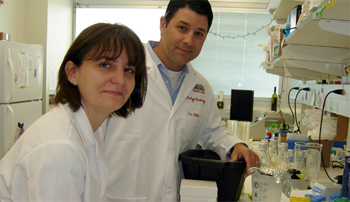 Like a switch that turns on a light, the mechanism that turns Staphylococcus aureus bacteria from harmless to deadly has been identified by Canadian scientists with the aid of UNMC researchers.
Like a switch that turns on a light, the mechanism that turns Staphylococcus aureus bacteria from harmless to deadly has been identified by Canadian scientists with the aid of UNMC researchers.
In an international collaboration, Paul Dunman, Ph.D., associate professor, pathology/microbiology, and his post doctoral trainee, Christelle Roux, Ph.D., provided key DNA microarray data on the breadth of activity that two molecules have to switch staph into an infectious organism.
Staphylococcus aureus, which kills about 100,000 Americans each year, would be harmless but for the action of the regulating molecules, or peptides.
 |
Christelle Roux, Ph.D., and Paul Dunman, Ph.D., recently contributed to a study that has major implications in the treatment of staph infections. |
“I’ve studied virulence factors for 10 years and have never seen anything of this magnitude,” said Dr. Dunman, a member of UNMC’s newly formed Center for Staphylococcal Research.
“These small peptides that allow staph to become infectious will be good targets for new drug discovery.”
The next step will be to study the mechanism to discover how the molecule regulates the virulence factors and to identify compounds that will inhibit the peptide, Dr. Dunman said.
The next phase of the study will be conducted by Nathan Magarvey, Ph.D., assistant professor, biochemistry, biomedical sciences and chemistry, McMaster University, Hamilton, Ontario, Canada.